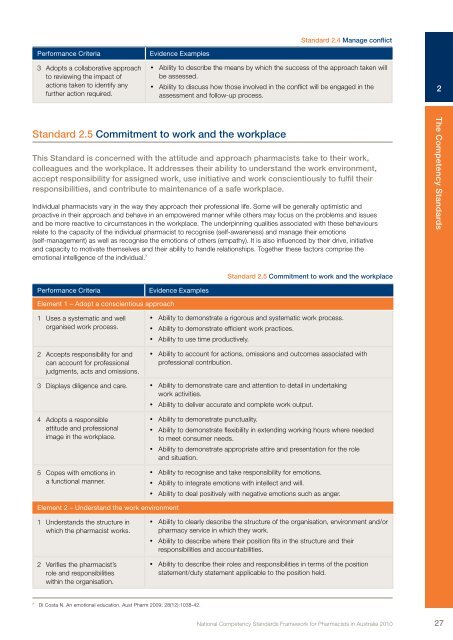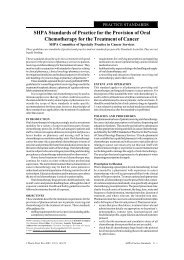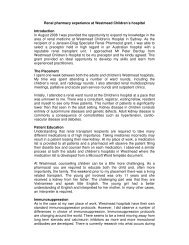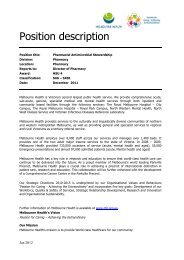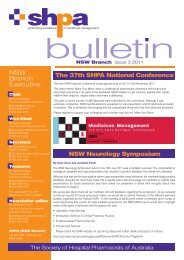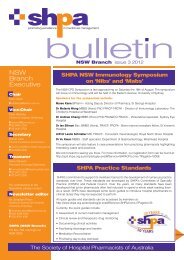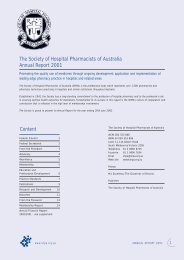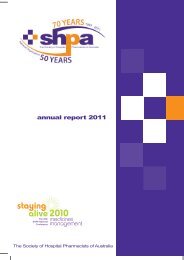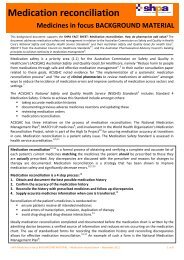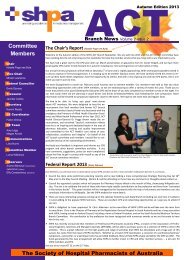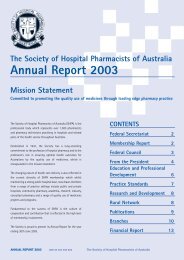National Competency Standards Framework for Pharmacists in ...
National Competency Standards Framework for Pharmacists in ...
National Competency Standards Framework for Pharmacists in ...
You also want an ePaper? Increase the reach of your titles
YUMPU automatically turns print PDFs into web optimized ePapers that Google loves.
Standard 2.4 Manage conflict<br />
Per<strong>for</strong>mance Criteria<br />
3 Adopts a collaborative approach<br />
to review<strong>in</strong>g the impact of<br />
actions taken to identify any<br />
further action required.<br />
Evidence Examples<br />
• Ability to describe the means by which the success of the approach taken will<br />
be assessed.<br />
• Ability to discuss how those <strong>in</strong>volved <strong>in</strong> the conflict will be engaged <strong>in</strong> the<br />
assessment and follow-up process.<br />
2<br />
Standard 2.5 Commitment to work and the workplace<br />
This Standard is concerned with the attitude and approach pharmacists take to their work,<br />
colleagues and the workplace. It addresses their ability to understand the work environment,<br />
accept responsibility <strong>for</strong> assigned work, use <strong>in</strong>itiative and work conscientiously to fulfil their<br />
responsibilities, and contribute to ma<strong>in</strong>tenance of a safe workplace.<br />
Individual pharmacists vary <strong>in</strong> the way they approach their professional life. Some will be generally optimistic and<br />
proactive <strong>in</strong> their approach and behave <strong>in</strong> an empowered manner while others may focus on the problems and issues<br />
and be more reactive to circumstances <strong>in</strong> the workplace. The underp<strong>in</strong>n<strong>in</strong>g qualities associated with these behaviours<br />
relate to the capacity of the <strong>in</strong>dividual pharmacist to recognise (self-awareness) and manage their emotions<br />
(self-management) as well as recognise the emotions of others (empathy). It is also <strong>in</strong>fluenced by their drive, <strong>in</strong>itiative<br />
and capacity to motivate themselves and their ability to handle relationships. Together these factors comprise the<br />
emotional <strong>in</strong>telligence of the <strong>in</strong>dividual. 7<br />
The <strong>Competency</strong> <strong>Standards</strong><br />
Standard 2.5 Commitment to work and the workplace<br />
Per<strong>for</strong>mance Criteria<br />
Evidence Examples<br />
Element 1 – Adopt a conscientious approach<br />
1 Uses a systematic and well<br />
organised work process.<br />
2 Accepts responsibility <strong>for</strong> and<br />
can account <strong>for</strong> professional<br />
judgments, acts and omissions.<br />
• Ability to demonstrate a rigorous and systematic work process.<br />
• Ability to demonstrate efficient work practices.<br />
• Ability to use time productively.<br />
• Ability to account <strong>for</strong> actions, omissions and outcomes associated with<br />
professional contribution.<br />
3 Displays diligence and care. • Ability to demonstrate care and attention to detail <strong>in</strong> undertak<strong>in</strong>g<br />
work activities.<br />
• Ability to deliver accurate and complete work output.<br />
4 Adopts a responsible<br />
attitude and professional<br />
image <strong>in</strong> the workplace.<br />
5 Copes with emotions <strong>in</strong><br />
a functional manner.<br />
• Ability to demonstrate punctuality.<br />
• Ability to demonstrate flexibility <strong>in</strong> extend<strong>in</strong>g work<strong>in</strong>g hours where needed<br />
to meet consumer needs.<br />
• Ability to demonstrate appropriate attire and presentation <strong>for</strong> the role<br />
and situation.<br />
• Ability to recognise and take responsibility <strong>for</strong> emotions.<br />
• Ability to <strong>in</strong>tegrate emotions with <strong>in</strong>tellect and will.<br />
• Ability to deal positively with negative emotions such as anger.<br />
Element 2 – Understand the work environment<br />
1 Understands the structure <strong>in</strong><br />
which the pharmacist works.<br />
2 Verifies the pharmacist’s<br />
role and responsibilities<br />
with<strong>in</strong> the organisation.<br />
• Ability to clearly describe the structure of the organisation, environment and/or<br />
pharmacy service <strong>in</strong> which they work.<br />
• Ability to describe where their position fits <strong>in</strong> the structure and their<br />
responsibilities and accountabilities.<br />
• Ability to describe their roles and responsibilities <strong>in</strong> terms of the position<br />
statement/duty statement applicable to the position held.<br />
7<br />
Di Costa N. An emotional education. Aust Pharm 2009; 28(12):1038-42.<br />
<strong>National</strong> <strong>Competency</strong> <strong>Standards</strong> <strong>Framework</strong> <strong>for</strong> <strong>Pharmacists</strong> <strong>in</strong> Australia 2010 27


